#utena symbolism
Text
Hair Symbolism in Utena
Not a very meaty post, but I haven’t found too many people talking about it in an explicit manner, much less point it out at all beyond the Utena/Anthy hair swap + student council design changes in Adolescence, which. Is a shame! Frankly it’s my favorite bit of symbolism from the entire show, along with the cars. Rest of the content under the cut
Long, straight, rigid forms represent masculinity in Ohtori, as curved, rounded, elegant forms represent femininity; this is reflected in the architecture of Ohtori Academy and other various symbols featured throughout the show (namely the swords and the birdcage, but there was also Touga’s masturbatory carrot that one time lol). This also applies to hair.
So far, I have down that:
Long/loose hair = arrogant, short-sighted, self-serving
Short/”done” hair = repression, ignorance, self-imposed suffering
Straight hair = Masculinity
Curly/wavy hair = Femininity
With this in mind, it’s interesting to note that Utena and Akio are the only characters whose designs incorporate aspects of both masculinity and femininity. Utena’s hair curls inwards at its tip, but is otherwise pretty straight. Akio’s hairstyle depends partially on the form he takes, but for the most part, it’s evident that the forefront of his hair is curly while the back hair is straight.


Furthermore, Anthy and Saionji’s hair looks... exactly the same. Which has some fascinating implications about Utena’s deconstruction of gender roles! (too lazy to find a bigger picture for Saionji lol. But it gets the point across). Of course, with themes of repression in the narrative, it’s also interesting to consider what Saionji having his hair tied up in a ponytail during certain scenes could signify. Though, we CAN surmise that, in Anthy’s case, it’s about her hiding the truth about her identity and masking her motives under the guise of a meek, subservient schoolgirl. But again, knowing Utena, I wouldn’t be surprised if it turned out there was something deeper than that going on in the writing.


There’s more, of course: Juri sports really, really, really tight curls when she’s just going about her daily life, projecting a cool and unperturbed facade, but when she has her hair down, you get some of the most emotionally charged scenes in the entirety of RGU. Tsuwabuki’s hair resembling Touga’s when he was young. Nanami’s hair hardly ever shown coming undone.
Anyway that’s the post byyeee
#revolutionary girl utena#utena#shoujo kakumei utena#sku#rgu meta#sku meta#rgu analysis#sku analysis#utena analysis#utena symbolism#exilley's diary#Codeword: Revolution#<-- for personal tagging purposes#im metaposting on main now#i guess.
214 notes
·
View notes
Text

Saw this, thought of the egg speech and now I'm like something something "the difference between the egg being nurtured and provided for so it will grow and someday break out of its shell and take flight" vs "the egg being seen as something only meant for consumption, to be broken and eaten" something something "how children are treated as possessions in our society" something something– [EXPLODES]
#revolutionary girl utena#nanami kiryuu#touga kiryuu#shoujo kakumei utena#sku#rgu#utena analysis#Of course‚ there's also the whole birdcage symbolism to consider too but I better slow down now or else– [EXPLODES AGAIN]#ambi utena post
618 notes
·
View notes
Text
I'm thinking of Marcille's bloodied hands putting Falin's skeleton in place to get her back. Bone by bone. I'm thinking of their interlocked hands in their intimate moments. Finger by finger.
I'm thinking of Kabru's hands pulling on Laios' sleeves, his confession caught in his throat ready to burst. I'm thinking of the way Laios embraces him with his hand over his chest.
#I'm. unwell. Dunmeshi made me unwell#Farcille#Labru#Marcille Donato#Falin Touden#Kabru#Laios Touden#wanna scream sooo bad but it's 5am and I'm at work#historically I am a hands symbolism kinda enby. you can blame Utena#Dungeon Meshi
579 notes
·
View notes
Text

The princess and the witch
.
Alt. ver., transparent and closeup:
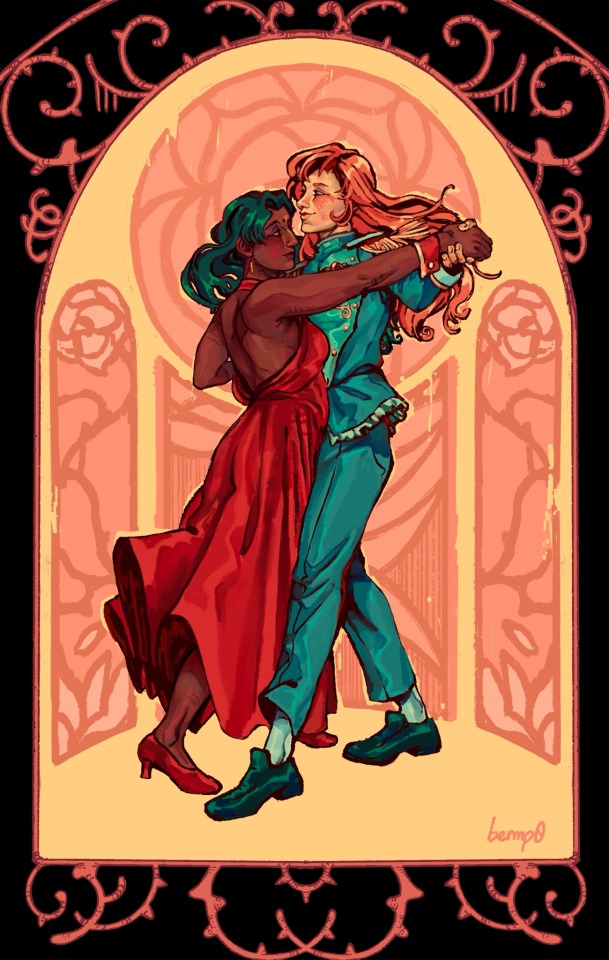
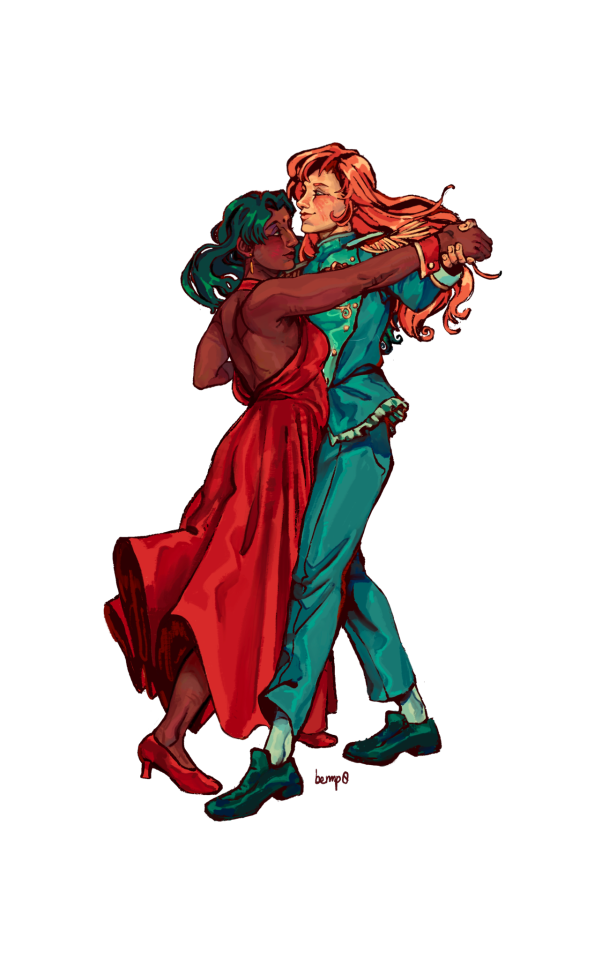
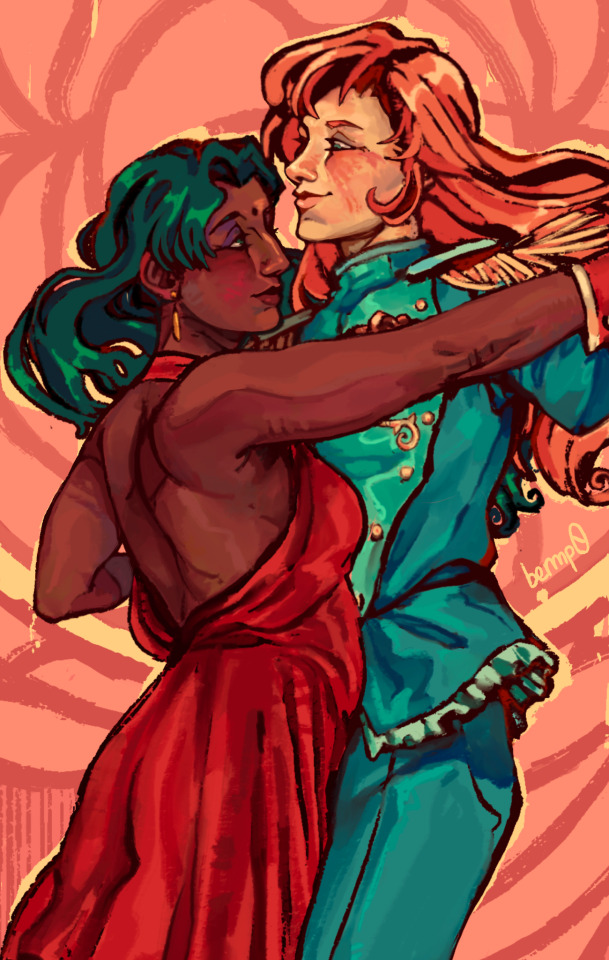
#10 hours on this and i hate it#sorry utena fans no symbolism on this one#rgu#revolutionary girl utena#shoujo kakumei utena#utena tenjou#sku#tenjou utena#anthy himemiya#himemiya anthy#rgu art#rgu fanart#digital art#utenanthy#fanart#myart#sku fanart#yeah yeah it is inspired by leyendecker and mucha and art nouveau and stained glass and everything else#featured
1K notes
·
View notes
Photo

A girl who cannot become a princess must become a witch
#when I said I only ship couples who engage in highly symbolic stabbing I wasn’t kidding#revolutionary girl utena#revolutionary girl utena fan art#utena x anthy#utenanthy#anthy himemiya#sarasadeart#cw: blood#cw: violence
3K notes
·
View notes
Text

miracles don't grow from flowers
how could you forgive her?
teardrops drip off daffodils
yet you swallow all that's bitter
#revolutionary girl utena#juri arisugawa#rgu fanart#rgu juri#shoujo kakumei utena#i adore juri#the flower crown is supposed to be from Shiori begging for forgiveness but i couldnt fit her in the composition so hands only#juri and shioris relationship is very interesting to meeeee#daffodils can symbolize forgiveness#i am always down for flower symbolism
542 notes
·
View notes
Text

The Witch and The Devil
#fan art#revolutionary girl utena#anthy himemiya#akio ohtori#i fucking hate akio#idk why i drew him i guess i had a vision or smth#artists on tumblr#fanart#digital drawing#right at u with another symbolism yay#if someone is reading this have a nice day :))#rgu
1K notes
·
View notes
Text


episode 1 / episode 39
#the ep 1 shot was when utena first saw the rose garden#anthy was in the garden watering the roses#the ep 39 shot was the first time we saw anthy after being separated from utena#revolutionary girl utena#shojo kakumei utena#shoujo kakumei utena#rgu#sku#utena tenjou#utena#anthy himemiya#anthy#utenanthy#i love them so very much#i am entirely consumed by utenanthy#i can't stop thinking about them#so much love#the credits were first placed in front of anthy at the right where utena stood before#the credits were then superimposed on the rose garden as anthy walked past it#you could say that the placement of credits from being in front of anthy to obstructing the rose garden was symbolic of anthy becoming free#free from the burdens of being the rose bride etc#i may be reading too much into this i'm sorry
395 notes
·
View notes
Text
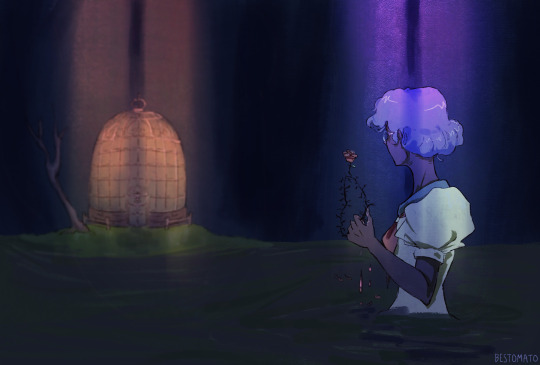
back again
#my art#anthy himemiya#revolutionary girl utena#rgu#NO SPOILERS IN NOTES!!!!! PLEASE i only just finished the 1st arc 😭#yesterday i did a late night photo shoot of me pretending to scream while pulling on my hair. this is how this anime got me#i love anthy i think it’s interesting to see how self sabotage is common behavior in abuse victims and how they connect that to the world#the visual department of this is SO GOOD. I LOVE ME A GOOD SYMBOLISM ALWAYS AND FOREVER!!!!!!#now i am going to sleep. good night!
423 notes
·
View notes
Text
I do sort of wish western anime fans would analyze anime and manga from a framework of japanese historical and cultural context. Specifically a lot of works from the 90s being influenced by the general aimlessness and ennui that a lot of people were experiencing due to the burst in the bubble economy and the national trauma caused by the sarin terrorist attack. I think in interacting with media that’s not local to our sociocultural/sociopolitical sphere it’s easy to forget that it’s influenced and shaped by the same kinds of factors that influence media within our own cultural dome and there ends up being this baseline misalignment of perception between the causative elements of a narrative and viewer interpretation of those elements. It’s a form of death of the author that i think, in some measure, hinders our ability to fully understand/come to terms with creator intent and the full scope of a work’s merits
#exilley's diary#this is about utena btw like. yeah its feminist and a coming of age horror story but also#it was in part ikuhara’s response to the changes he observed in the corporate anime industry and an attempt to subvert those trends#it doesnt really help that i feel certain aspects of the show are filtered through translation and certain cultural emphasises are lost#like for instance. the blood type symbolism. or wakaba’s gestures with making packed lunches#theyre incredibly japanese expressions of conventional gender roles that non-japanese audiences might not fully resonate with
10K notes
·
View notes
Text
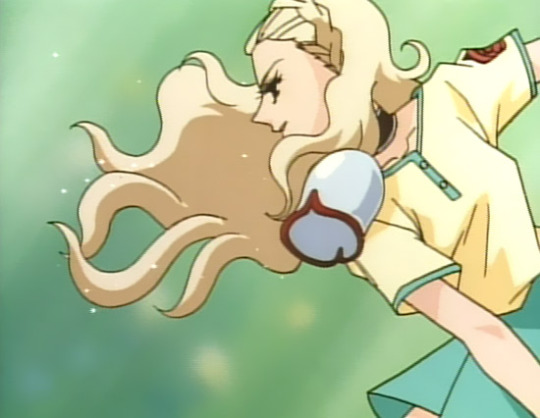

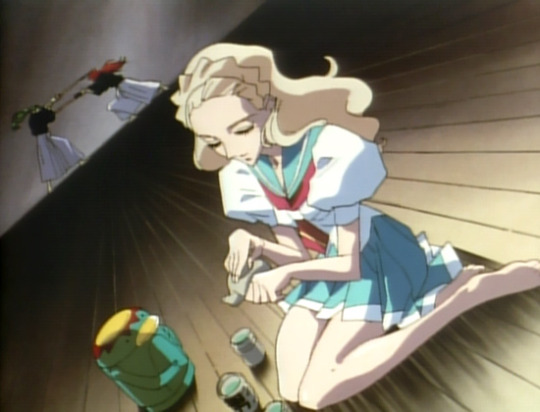

thinking about the nanami-wakaba parallels
#revolutionary girl utena#shoujo kakumei utena#rgu#nanami kiryuu#wakaba shinohara#nanami x wakaba#pov: you are just an ordinary girl who desperately try to become special but it only hurts#you become “empovered” that one time because of ohtori's grooming only to realize that i was never real empowerment#you own a cappa#also thinking about the cappa symbolism....
87 notes
·
View notes
Text
So, I finally watched the Utena movie after making my sibling watch the show with me. We both loved it and there was something that I pointed out while watching that I wanted share with tumblr because I feel like this crowd would appreciate it.
So, spoilers, in the movie Utena becomes a car. After she becomes a car Anthy gets inside and starts driving, and as they go along, they take some damage and the first thought I had while watching this part of the film was this:
The crumple zone is an integral part of a safe vehicle. The damage sustained in an impact that causes it to crumple absorbing a lot of the force that could harm the person inside. This has become more well known because of how the shitty Tesla tank cars are death traps (or at least that’s why I know about it).
So all I could think as I was watching Anthy drive Utena, taking damage along the way, Is how every dent and scar on that car was keeping Anthy safe. Even when she wasn’t human and wasn’t in control, Utena was protecting her. She was built to protect Anthy.
#this thought made me so emotional while watching the film#so I had to share because I know that folks who live Utena love symbolism and crying over our girls#they are in love your honor#revolutionary girl utena#utena tenjou#anthy himemiya#utena x anthy#adolescence of utena#utena spoilers
116 notes
·
View notes
Text
hater alert! far too many people say that juri’s character arc ‘isn’t about her being sad about being gay, it’s about being sad about unrequited love that happens to be gay’ and. well. that is not true and by saying that you are completely flattening the brilliance of juri’s character arc which literally culminates in her being able to accept her own lesbianism despite her unrequited love, despite all her shame and self-loathing, despite this pursuit by Some Fucking Guy to try and ‘save’ her from these feelings. like if you think juri’s entire character is just ‘sad about shiori’ how do you appreciate even a modicum of the emotion packed into that final juri duel. it is both about shiori and, even broader, her lesbian identity and what that means to her intrinsically as a person, removed from romantic relationships and just purely as like. you know. Who She Is. the idea that even when juri’s locket is cut from her neck she is still a lesbian that’s still who she is and she cant change that and, crucially, she doesn’t want to even as she is agonised by these feelings. that’s why she forfeits the duel!!!! she’s clocking out she’s quitting she’s saying no!!!!!! this is me and ive got to be ok with that this is me and i can accept that this girl might not love me and i can keep living despite that. like. god im so normal arisugawa juri im so sorry that no one understands you and your intrinsically unapologetically lesbian storyline like i do
#ok got that out of my system now (rewatched ep 29 duel too many times)#revolutionary girl utena#rgu#idk i just see that argument so much and it makes me so sad#bc i get where ppl r coming from there r a lot of unnuanced ‘sad bc gay’ narratives out there#but juri’s whole arc is about actively challenging and deconstructing that idea#and it deals with the sadness that comes with being closeted with knowing youre gay and not really liking that about yourself#and eventually she does accept and embrace that aspect of herself but CRUCIALLY she doesnt do it via romantic validation#in fact she does it in the face of like. All Opposition Ever#no one says hey juri if you were gay that’d be totally fine actually haha#ruka tries to save her from her lesbianism!!!!!!!! like!!!!!!!#it is juri and juri alone who makes this resolution and that is just So Fucking Important to me#shes so. she is the queer character of all time to me i literally dont care no one else will ever come close#LIKE!!!!!!! THE CASTLE WEEPING ON HER WHEN SHE MAKES HER CHOICE!!!!!!!#accepting that part of yourself and having the symbol of matrimony and heteronormativity WEEP over you#no one ever validates juri’s choice to accept her queerness but she keeps making that choice#and her in episode 37…….. god i just might keel over and die girls when juri utena touga parallels……#anywayyyyyyy love and light i love juriposting#shut up daisy
360 notes
·
View notes
Text
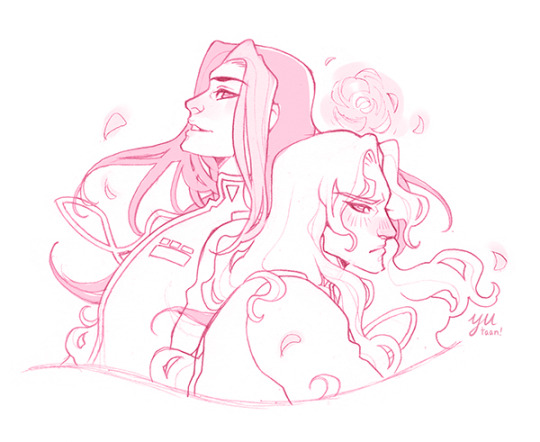
Touga and Saionji, two Very Good Friends
#revolutionary girl utena#shoujo kakumei utena#touga kiryuu#kyouichi saionji#doodles#sketches#they're so POINTY#I somewhat based the pose on that bit where they're on the tandem bike#and Touga stops pedaling and flops backwards against Saionji#it's symbolism! Saionji is there to provide support!#(he is there to be flopped upon)#anyway! this might end up becoming a papercraft!#I'll see if I can find good papers for these somewhat terrible lads
344 notes
·
View notes
Text
why is utena's uniform black? within the show, the color white represents the prince, or the idea of princehood, which is why utena wears a white rose in the duels, and why dios' (and akio's) uniform is white, and by extension why the student council uniforms are too. so the fact that the main color utena wears is the opposite of that is significant. i think the black of utena's uniform is mainly meant to stand in contrast to the student council, to show that she's not like them, that she's an outsider. it's also important that it's in contrast to the prince's uniform; she's playing a role she can never really fill. she cannot become a prince, and she doesn't really, truly, want to either. or she wouldn't, knowing what it really means. her uniform is a way of expressing her masculinity, and whether she realizes it or not, the way she does that does not entirely line up with being a prince. it exists outside of that. this is of course a good thing.
the red accents are interesting too, because it's a color very heavily associated with akio and anthy (and touga, obviously, but i don't think that's directly relevant when it comes to why utena wears it.) in this way utena's outfit also works as a sort of inversion of akio's outfit when he's not playing prince: red vs black shirt, black vs red pants (or shorts in her case.) then there's the red of anthy's rose bride dress. red accents are present in the white uniforms of the prince and the student council too. the dresses utena wears in episode 3 and 33, as well as the girl's uniform, are also white (or very close to it) with red accents. the sweater she wears in episode 37 is entirely red. utena's rose bride dress does not have any red on it, unlike anthy's, and it isn't white either; it's pink, a combination of the two colors, like her hair. i'm not completely sure what all this means, but it's interesting that the moments utena wears colors closer to white, to the prince's color, are the very moments she's the least masculine and "princely" (the two are seperate, but in these cases connected.) perhaps white is not just the color of the prince, but the princess as well? is red the color of the witch, then?
in the movie, utena's uniform is both black and white and does not have any red until she's in her dueling outfit, where she gets red stripes between the black and the white, as well as on her epaulets and shoes. and here anthy's rose bride dress is no longer fully red, but mostly white with red accents like utena's uniform (if white is the prince's color, does this reflect anthy's more proactive role in the movie? is she not playing utena's saviour in many ways here?) an important part of the movie's ending is anthy and utena both shedding their clothes entirely, and their roles along with them. so whatever meaning the colors may or may not have held, they're free of that now.
#revolutionary girl utena#analysis#well. not so much analysis as just a bunch of disconnected thoughts and observations#i'll admit color symbolism is not my strong suit. but i find it very interesting#utena#anthy#akio#adolescence of utena
128 notes
·
View notes
Text
Thinking about how parents usually say "don't get into a stranger's car" and how the implocation is that they are going to kidnap you, kill you or assault you (or everything). And Akio uses his car for abuse, either doing it there or driving the victim to the place where the abuse is going to happen. In some cases, even though he is a stranger, the victims know he exists and is an authority in the school. In others, he grooms them and gets them to trust him, so he makes sure that the warning no longer applies to him.
His power as an adult and how, with his car, he has more freedom than the kids. He can go wherever he wants. He uses the car as a private space where he doesn't need to respond for his actions. And if the kids want to go somewhere that is not inside Ohtori, they need him to take them. They have to get into his car to be able to grasp a little freedom.
This just makes me want to read more about youth liberation and how young people are a class in contradiction with adults.
#akio ohtori#rgu analysis#rgu#revolutionary girl utena#shoujo kakumei utena#cw grooming mention#cw abuse#cw sa#cw csa#theme: abuse#theme: adult opression#character: ohtori akio#brainrot but in a way where my anciety makes me write random things#well the car is not that symbolic anymore#symbolism: car#gru
56 notes
·
View notes